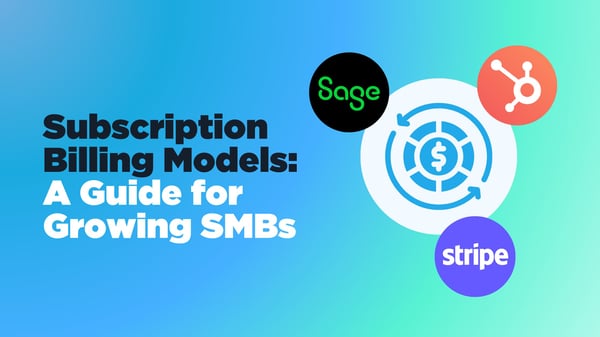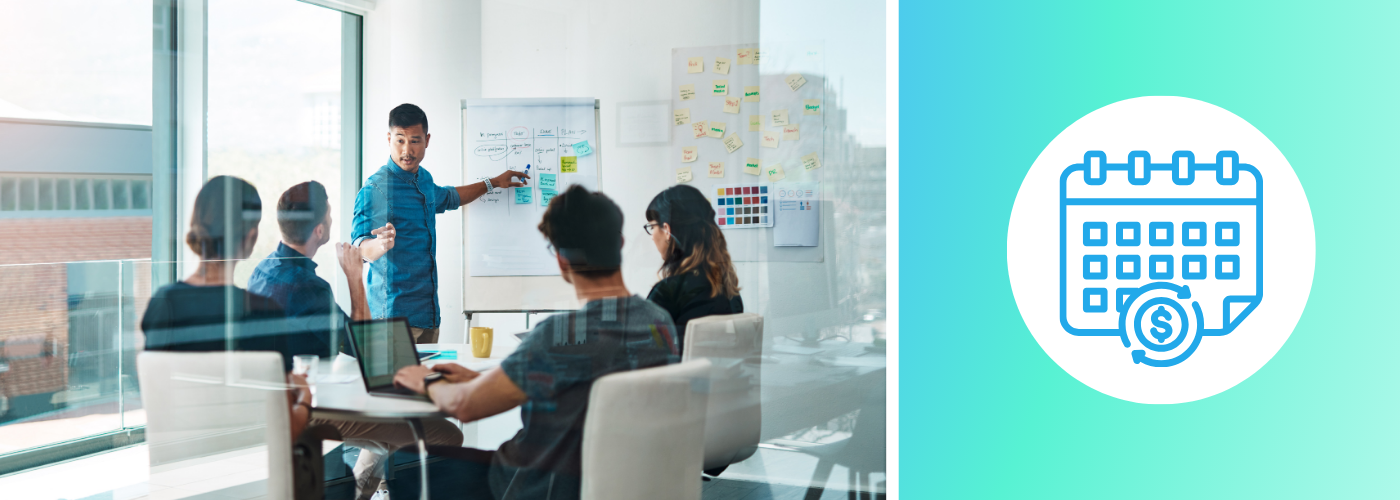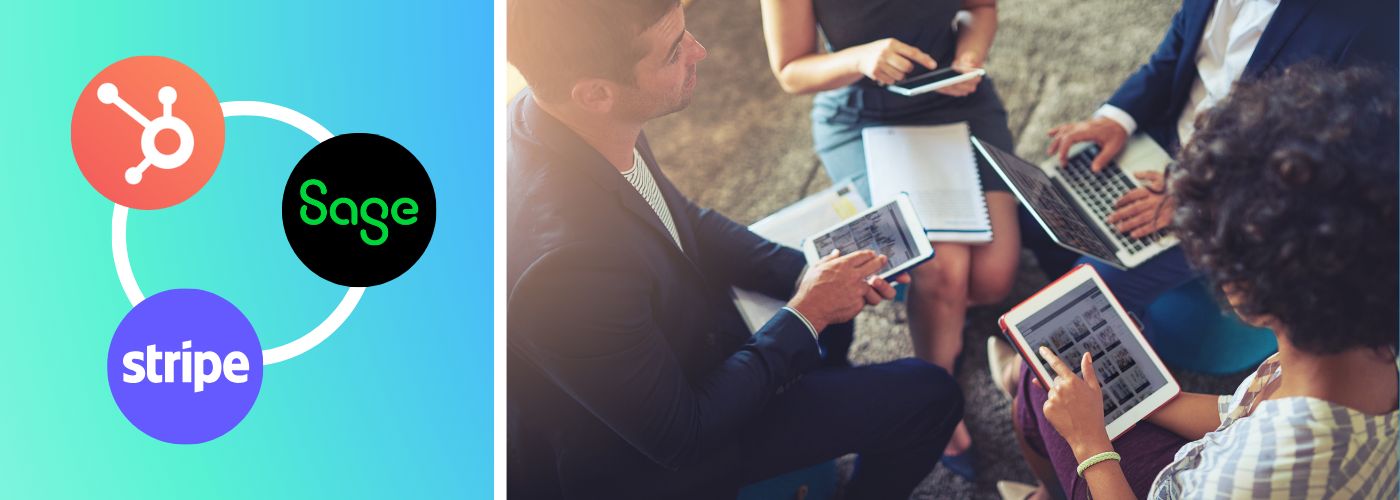Subscription Billing Models: A Guide for Growing SMBs
Written byMelissa Bell

Subscription services are on the rise across all types of businesses. According to recent statistics, the subscription economy is predicted to grow to USD 1.5 trillion.
Research also shows that buyers are more likely to purchase from brands offering a personalized subscription experience. This explains why SMBs are turning to best-of-breed applications like Stripe for collecting payments, HubSpot for managing sales & customer data, and Sage Intacct for accounting & financial reporting.
Not only do tools like these support recurring billing models for more predictable revenue, but they also collect information about customers that can be used to enhance customer experiences.
However, successfully leveraging multiple best-of-breed applications in tandem to get the most from subscriptions often requires upfront planning and system integration.
This blog will walk through key considerations for SMBs new to subscriptions, including:
- Choosing a subscription billing model
- Configuring recurring payments
- Managing ongoing subscriptions
- Leveraging subscriber data
We’ll also include a step-by-step example of a subscription order flow based on a demonstration of real integrated software designed for streamlining billing.
Choosing a Subscription Billing Model
The first step is determining the right recurring billing approach aligned to your business model, target customers, and industry. Key options to consider include:
- Billing frequency (monthly vs. annual subscriptions)
- Flexible pricing tiers (volume discounts, seat-based plans)
- Usage or metered billing (pay-per-use pricing models)
Key options like billing frequency, plan flexibility, and metered pricing allow SMBs to create a customized model. As with a lot of the clients we work with, one size doesn’t always fit all. In fact, when there is a standard or pre-built integration between apps that meets a client’s need, we recommend utilizing it. The integrations we often build are for clients with more complex processes in highly scalable environments.
|
Let’s explore an example configuration for a company with these parameters in our test environment.
Acme Inc. is a small B2B SaaS company selling workspace collaboration software on a subscription basis. The company determines it can support a monthly and annual billing cycle based on average deal sizes and sales team input. They enable both options. For pricing, they configure a fixed rate per “seat” of $20 per month. Volume discounts apply for annual prepayment. For example, an annual plan reduces the effective monthly price per seat by 10%. |
Configuring Recurring Payments
With core billing rules established, the next priority is configuring systems to streamline subscription management processes.
Priorities should include:
- Product configuration in the CRM catalog (or establish pricing tears)
- CRM and ERP integration to establish automated order/billing workflows
- Payment gateway integration to collect subscription fees
|
In preparation for launch, Acme Inc. will need to complete key software configuration in the following order:
Once completed, Acme will begin seeing the benefits of an integrated “quote-to-cash” workflow spanning new sales orders to subscription renewals. |
Subscription Billing Automation Example
Organizations using HubSpot CRM, Stripe for payment processing, and Sage Intacct for financial management can set up automated workflows via a three-way integration:
Managing Ongoing Subscriptions
Post-launch, actively monitoring the health of subscription accounts becomes vital for retention and growth. Examples of these might include:
- Automated renewals and invoice generation
- Failed payment recovery procedures
- Usage allotment tracking (if metered plans)
- Self-service account portals
Post-launch, actively monitoring the health of subscription accounts becomes vital for retention and revenue growth. Robust management of your subscriber base should include automated processes for:
Renewals and Invoice Generation
Leverage automation to send invoices on schedule and prompt timely renewals. This reduces administrative workload while ensuring the continuity of billing cycles. Set renewal reminders at appropriate intervals to limit failures.
Failed Payment Follow Up
Despite best efforts, some payments still fail. Implement effective dunning strategies to refresh expired cards, retry transactions, and engage with customers who are likely to cancel their subscriptions. Prioritize saving these accounts through personalized outreach.
Usage Allotment Tracking
For businesses with metered subscription plans based on usage or seats, ensure you have visibility into customer usage trends. This allows billing amounts to dynamically align to actual consumption. Have real-time metrics on usage available in self-service subscriber portals.
Account Management Portals
Providing customers easy access to account details, statements, usage, and payment options fosters greater engagement beyond just transactions, especially for online businesses. Develop your subscriber site experience with the mindset of building loyalty and brand affinity with convenience features.
|
Let’s return to our friends at Acme Inc. With over 100 active subscribers to manage, Acme Inc.’s finance team utilizes Sage Intacct automation to:
By staying on top of tasks like these, the Acme team maintains strong customer lifecycles. |
Leveraging Subscriber Data
A major benefit of robust billing processes is the wealth of customer data it generates. By centralizing data across integrated systems, businesses gain complete visibility into subscriber metrics empowering insights such as:
Conversion Rates from Trials
What it means: Understand the percentage of free trial users converting into paid accounts.
Why it matters: This indicates the effectiveness of trial positioning to attract ideal customers. Use conversion benchmarks to test pricing page layouts and trial extension/expiration policies.
Average Revenue Per Account
What it means: Segment subscriber accounts by pricing tier over time to calculate consistent growth or decline in average contract value (ACV).
Why it matters: Allows you to evaluate the penetration of premium plans or identify downgrade risks for specific cohorts.
Account Location and Firmographics
What it means: Enriched subscriber profiles with billing details like company size, industry vertical, and location enables targeted marketing.
Why it matters: Geo-locate accounts to uncover regional customer concentrations to guide events, referral incentives, and localization priorities.
Churn Risk and Renewals
What it means: Leverage subscription expiration dates and usage levels to predict renewal propensity.
Why it matters: Identify subscribers with lagging engagement, in domains with high turnover, or late payment history to take proactive retention or cross-sell actions.
|
For Acme Inc, integrated HubSpot, Sage Intacct, and Stripe data powers everything from personalized subscription marketing to pricing strategy refinements based on quantifiable metrics including:
This empowers data-driven decisions on pricing, feature development, and retention campaigns. |
Key Takeaways
To recap, core planning steps for optimizing billing include:
- Consult experts to select models
- Map-required technology integrations
- Build efficient customer account portals
- Monitor subscriber data and trends
In the conclusion of our example, Acme Inc. is primed for expansion thanks to upfront investments in subscription management. Their platforms can effectively support special offers and metered plans per account as well as include advanced cohort analysis for smarter marketing.
One interesting fact before you go: subscription-based companies have grown 4.6 times faster than the S&P 500 has in the last 10 years. That's a big difference considering many of the 500 companies in the S&P are older than subscriptions became a trend.
Interested in assessing your own organization's recurring billing readiness? Schedule a free consultation with an integration expert to explore what’s possible.

About the Author
Melissa Bell
Director of Sales & Marketing



.png?width=1400&height=500&name=Subscription%20Billing%20Integration%20-%20HubSpot%20Stripe%20Sage%20Intacct%20(2240%20x%20800%20px).png)
%20(1).png?width=1400&height=500&name=Subscription%20Billing%20Integration%20-%20HubSpot%20Stripe%20Sage%20Intacct%20(2240%20x%20800%20px)%20(1).png)
